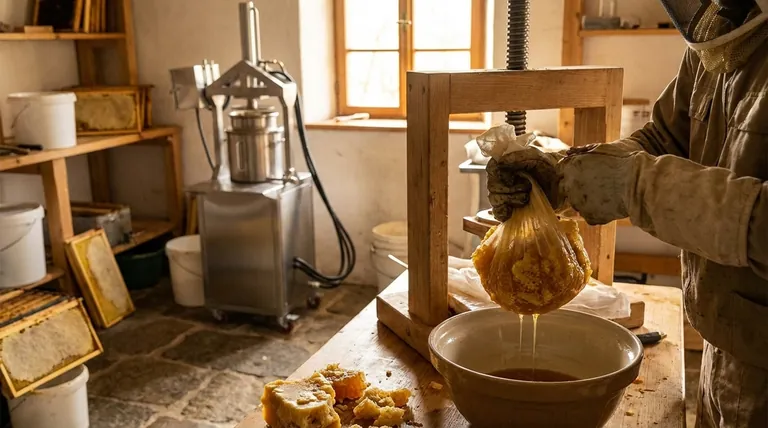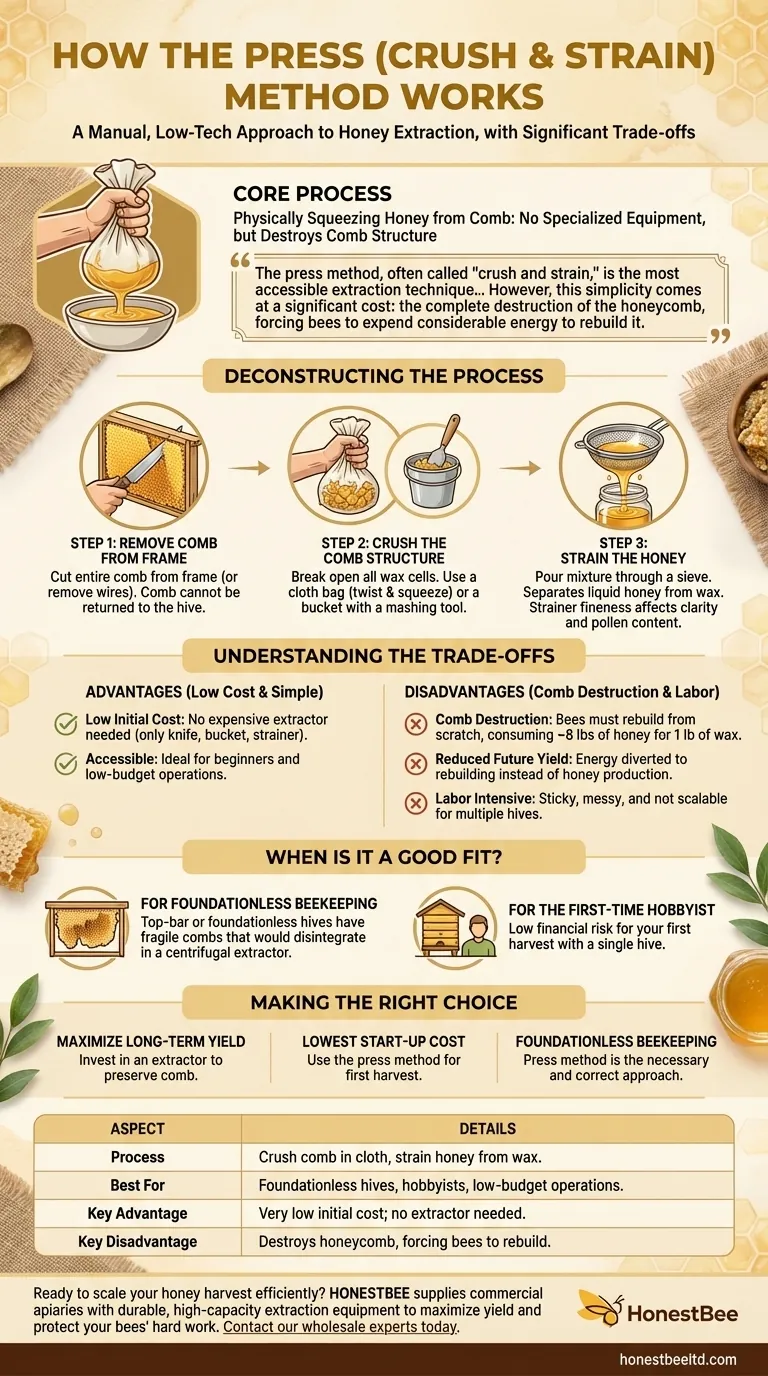At its core, the press method of honey extraction is a simple, manual process of physically squeezing honey out of the comb. Beekeepers cut the honeycomb from its frame, wrap it in a durable cloth like calico, and then twist or press the bundle to force the honey through the cloth, leaving the wax behind.
The press method, often called "crush and strain," is the most accessible extraction technique, requiring no specialized equipment. However, this simplicity comes at a significant cost: the complete destruction of the honeycomb, forcing bees to expend considerable energy to rebuild it.

Deconstructing the Press (Crush and Strain) Method
This technique is valued for its straightforward, low-tech approach, making it a common choice for new hobbyists or those with specific types of hives.
Step 1: Remove Comb from the Frame
The process begins by cutting the entire honeycomb away from the wooden or plastic frame. If the frame uses support wires, these must be carefully removed from the wax.
This step immediately commits you to the process, as the comb cannot be returned to the hive.
Step 2: Crush the Comb Structure
The piece of honeycomb is then placed inside a filter bag, a strong cloth like calico, or a simple bucket. The goal is to break open all the individual wax cells that hold the honey.
This can be done by hand by squeezing and twisting the cloth bag, or by using a tool to mash the comb inside a bucket.
Step 3: Strain the Honey
Once crushed, the mixture of raw honey and wax pieces is poured through a sieve or mesh strainer. This separates the liquid honey from the solid wax.
The fineness of the strainer determines the final clarity. A coarse filter may leave more pollen grains, which can contribute to a more robust flavor and nutritional profile. The collected honey is then ready for bottling.
Understanding the Trade-offs
Choosing an extraction method is a strategic decision that impacts both you and your bees. The press method has clear benefits and significant drawbacks.
The Primary Advantage: Low Initial Cost
This method's greatest strength is its accessibility. It requires no expensive machinery like a centrifugal extractor, which can cost hundreds or even thousands of dollars. You only need basic tools: a knife, a bucket, and a strainer.
The Critical Disadvantage: Comb Destruction
The major downside is that the honeycomb is completely destroyed. Bees expend enormous energy to produce wax and draw it into a perfect comb structure—it's estimated they consume up to eight pounds of honey to create just one pound of wax.
Destroying the comb forces the colony to rebuild from scratch. This diverts their energy away from foraging and honey production, ultimately reducing your potential harvest in the following season.
Labor and Efficiency
The press method is sticky, messy, and labor-intensive. While effective for one or two hives, it does not scale well. For beekeepers managing multiple colonies, it quickly becomes impractical.
When is the Press Method a Good Fit?
Despite its major drawback, there are specific scenarios where this method is not just an option, but the standard and most logical choice.
For Foundationless Beekeeping
Hives that don't use a rigid foundation, such as top-bar hives or frames without a plastic or wax foundation sheet, produce more fragile combs. These combs cannot withstand the force of a centrifugal extractor and would disintegrate.
For these beekeeping styles, the crush and strain method is the primary and intended way to harvest honey.
For the First-Time Hobbyist
If you have one hive and are unsure about your long-term commitment to the hobby, the press method is a perfectly viable way to get your first harvest without a major financial investment.
Making the Right Choice for Your Goal
Your beekeeping philosophy and goals should dictate your extraction method.
- If your primary focus is maximizing long-term honey yield: Invest in an extractor for standard frames to preserve the drawn comb and the bees' energy.
- If your primary focus is the lowest possible start-up cost: The press method is a practical and effective way to process your first harvest.
- If your primary focus is practicing foundationless beekeeping: The press (crush and strain) method is the necessary and correct approach for your hives.
Ultimately, choosing the right technique is about balancing equipment cost against the time and energy of both you and your bees.
Summary Table:
| Aspect | Details |
|---|---|
| Process | Crush comb in cloth, strain honey from wax. |
| Best For | Foundationless hives, hobbyists, low-budget operations. |
| Key Advantage | Very low initial cost; no extractor needed. |
| Key Disadvantage | Destroys honeycomb, forcing bees to rebuild. |
Ready to scale your honey harvest efficiently? As HONESTBEE, we supply commercial apiaries and distributors with the durable, high-capacity extraction equipment needed to maximize yield and protect your bees' hard work. Contact our wholesale experts today to discuss the right solutions for your operation.
Visual Guide

Related Products
- Electric Honey Press Machine for Squeezing Honey Comb Press Equipment
- 10L Stainless Steel Electric Honey Press Machine
- Stainless Steel Honey Press Wax Press with Tank
- HONESTBEE 72 Frame Industrial Electric Honey Extractor for Beekeeping
- Stainless Steel Manual Honey Press with Guard for Pressing Honey and Wax
People Also Ask
- What are the unique characteristics of honey presses? Maximize Honey Yield for Small-Scale Beekeeping
- What are the benefits of using a honey press for Warré or Top Bar beehives? Maximize Your Natural Harvest
- How does a honey press work? A Guide to Simple, High-Yield Honey Extraction
- How can the honey press be cleaned after use? A Step-by-Step Guide for Commercial Beekeepers
- How does using a honey press affect honeycomb reuse? It Destroys Comb but Captures Unique Honey & Wax



















